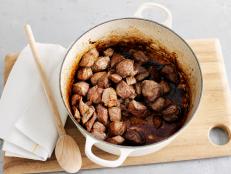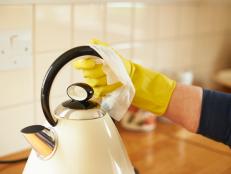How to Prevent Food From Sticking to Your Stainless Steel Skillet
Avoid these mistakes and your food will never stick again.


Candice Bell/Getty Images
Stainless steel pans have some major advantages over their nonstick and cast iron counterparts: they’re perfect for searing proteins (and getting that elusive crispy skin); you can prepare acidic foods in them (a no-no for cast iron); and you can use metal utensils without worrying about scratching the surface. But many home cooks avoid using stainless steel for delicate dishes like fish or scrambled eggs for fear the food will stick and tear. Which naturally got us wondering: Is there a way to season stainless steel so that it becomes permanently nonstick? We consulted experts from two of our favorite stainless steel skillet companies for the answer: Alice A. Staley, Vice President of Cuisinart Non-Electronics, and Wendy Dyer, Director of Strategic Marketing at All-Clad.
According to Staley and Dyer, while it isn't possible to make a stainless steel pan permanently nonstick, there are steps you can take while cooking to ensure your food never sticks. Turns out if your food is sticking to stainless steel, it probably means you're using the pan incorrectly. Follow the tried-and-tested method below, and you’ll be saying goodbye to sticking and hello to stainless steel as your new kitchen workhorse.

LauriPatterson/Getty Images
Step 1: Bring Food to Room Temperature
Remove your protein from the refrigerator 15 minutes before you want to start cooking and let it come closer to room temperature.
Step 2: Preheat the Skillet
Preheat a dry skillet for 1-2 minutes over medium or medium-low heat. According to Staley, failing to preheat the pan makes foods more likely to stick, as does cooking over high heat, which degrades the fat in the skillet and reduces the barrier between the food and the stainless steel.
Step 3: Perform the Water Droplet Test
Use the water droplet test to check if your pan is properly preheated. Drizzle a few drops of water into the skillet. If the water fizzles or does nothing, the pan isn’t preheated enough. Preheat it for longer. If the water splits into tiny beads, the skillet is too hot. Reduce the heat to let it cool down. “The pan is ready for use when the water becomes a slippery droplet that slides around the skillet surface,” explains Staley.
Step 4: Add Oil to the Skillet
Once the pan is preheated, add oil or cold butter and allow the fat to heat up before adding food. “This ‘hot pan, cold fat’ method prevents food from sticking,” Staley says.
Step 5: Add Food to the Skillet
When the oil is properly preheated, it’ll shimmer and thin, moving like water, Dyer says. Add the ingredients at this point.
Step 6: Test with a Spatula
When you think one side of the food is done cooking, try pushing it with a spatula. If it’s ready to flip, the food will release easily. If you feel any resistance, give it another minute, then try again. Prematurely turning food is a common mistake that causes sticking, Dyer says.
Step 7: Clean Very Well After Use
“To optimize the release of your nonstick pan, it’s important to keep the surface very clean after each use,” explains Dyer. For pans that are only slightly dirty, wait until they’re cool to the touch, then soak them in dish detergent and warm water, and scrub. For pans with dark food residue, start on the stovetop: simmer some water with a drop of dish soap, then use a wooden spoon to gently loosen the food particles. If you’re not satisfied after handwashing, a follow-up with our favorite stainless steel pan cleaner can work wonders on any unwanted residue.
5 Best Stainless Steel Skillets, Tested by Food Network Kitchen
We discovered which stainless steel frying pans really sizzle, not to mention shallow fry, steam and saute.
Related Links:
































